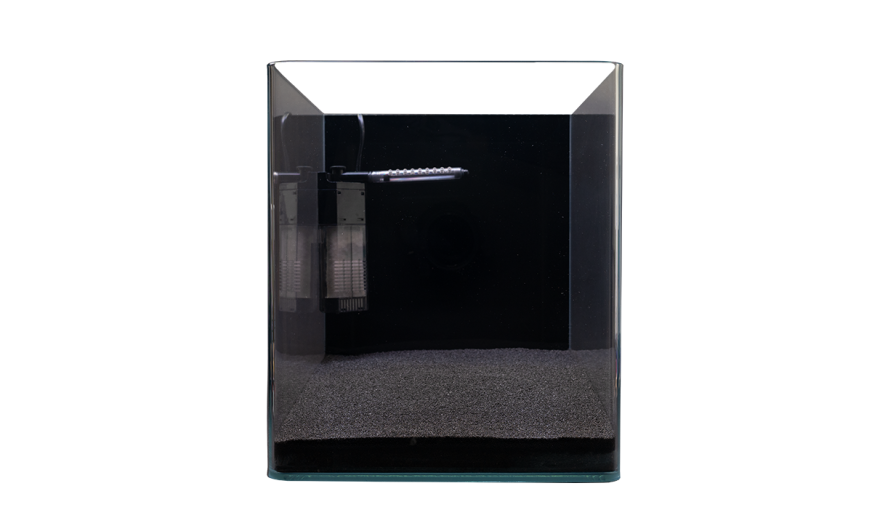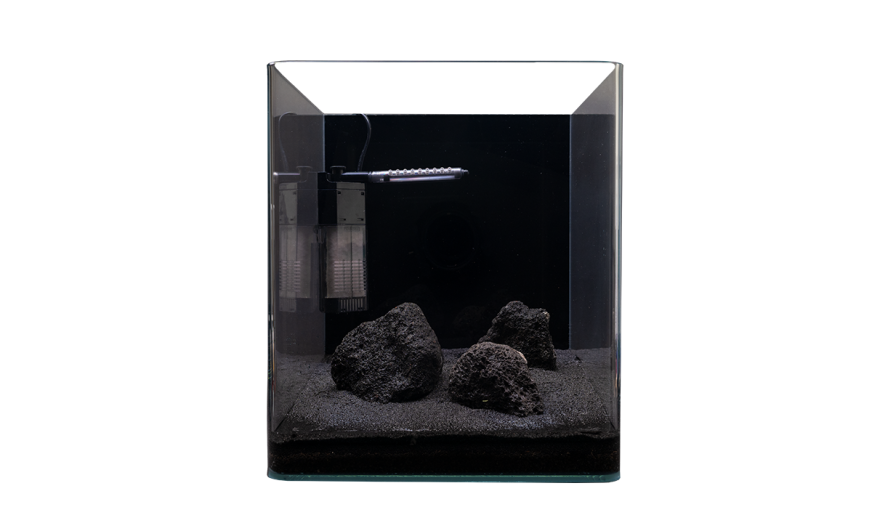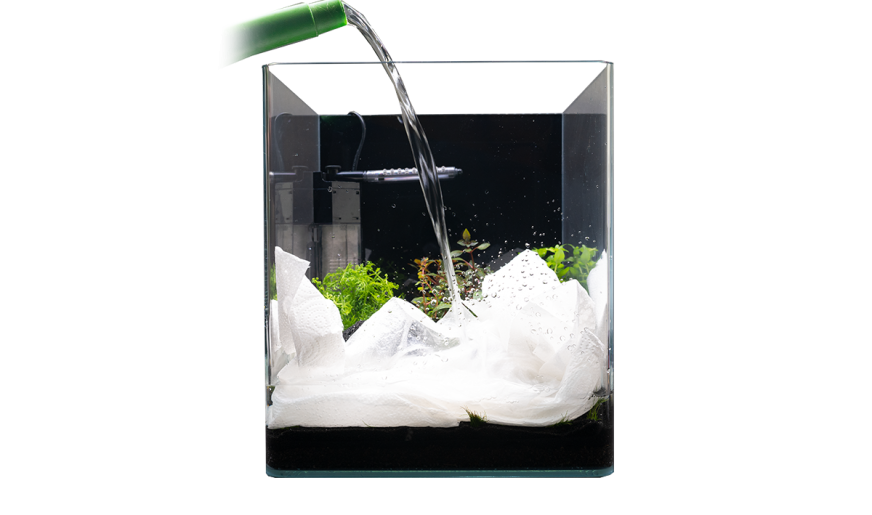The right location for an aquarium
Ideally, your aquarium should be located in a dark, quiet place without loud noises or vibrations. Direct sunlight can encourage algae growth and, especially in the summer, can cause the water to heat up considerably. Many fish suffer tremendous stress if there is a lot of activity around them, for example, if the aquarium is placed on a dresser with drawers being opened and closed several times a day, or right next to a subwoofer.
Important: The aquarium must be placed on a horizontal, level and appropriately loadable surface. Even a grain of sand between the bottom pane and the cabinet can cause stress in the glass and lead to cracks. Please always use a safety carpet pad that compensates for slight unevenness in the substrate and also serves as thermal insulation.
Preparations
Rinse your new aquarium with tap water to remove production residue and dust. You do not need a cleaning agent. If you want to add a backsheet to the aquarium, now is the time to do it.
Prepare gravel, roots & stones
If you use aquarium gravel as substrate, rinse it well in a bucket of tap water to remove dust and debris. For larger quantities, washing through in an old pillowcase has proven successful. If you are using Aquarium Soil, please do not wash it out!
Roots are a great natural aquarium decoration. With roots from the forest or fresh driftwood you can introduce all kinds of unpleasant things into the aquarium. Please use suitable roots from the pet shop!
Often aquarium roots give off tannins, and depending on the species they float for a longer time. If you pre-water them in a bucket for a few days, they will sink immediately and will not stain the water as much. You should change the water in the bucket more often. Especially stubborn candidates, which do not want to stay down, can be weighed down with a stone. Eventually, even the most stubborn root will become waterlogged and stay down.
Prepare plants
Before planting the aquarium, it is best to draw a rough planting plan. This way, the plants can be planted quickly and everything will be in the right place.
Potted and bunched plants for aquaria with fish should be pre-soaked for 24 hours in a bucket of fresh water at room temperature to rinse out any residue from growing the plants. Remove the pot and rockwool beforehand, or the clips in the case of fretted plants. Plants for a shrimp aquarium should be pre-watered for one, better two weeks, because the little crawlers are very sensitive to pesticides. Until then, place the bucket in a bright place or light it with a small aquarium light. You should change the water several times to remove residues as completely as possible.
In the case of plants in an in-vitro cup, on the other hand, you rinse off the nutrient substrate and can then use them immediately. No pesticides are used in their cultivation.
How to set up your aquarium

- The construction of the substrate
First of all, fill in the Deponit mix as a nutrient substrate to a height of approx. 1 – 2 cm and distribute it evenly. If you leave a distance of approx.
1 – 2 cm to the aquarium glass on all sides, you will not see any layers from the outside later. Then fill in washed aquarium gravel to a height of approx. 3 – 4 cm.
If you use Soil, you do not need a nutrient medium. It is filled in 4 – 5 cm high.
Tip: If you allow the substrate to rise slightly towards the back, it will give the impression of greater depth.

- Insert technology
Position filter and heater before decorating to avoid space problems later. Please do not put them into operation yet! You can hide the equipment behind plants or decoration later.

- Insert decoration
Now you place the decoration: aquarium suitable stones, roots, suitable ceramic decoration, … There are no limits to your creativity!
The stones must be as water-neutral as possible for use in the aquarium and must not release any undesirable substances. Decorative pebbles such as Dennerle natural pebbles can be used to create great accents.
Tip: An uneven number of different sized stones or decorative elements looks more natural. So that the decoration does not look artificial, push it a little into the gravel.
An aquarium arrangement according to the golden section has proven itself. Here, the optical center of gravity is not in the middle, but slightly shifted to the side. This looks more harmonious and natural.

- Insert plants
Immediately before planting, remove the lowest leaves of stem plants, but leave the leaf stalks as “anchors”. In this way, the plants will float less when water is added. Cut back the roots to 4 – 5 cm.
With Cryptocorynes and Sims you can cut off all leaves without hesitation; they would fall apart anyway when you put them in the water. The plants will sprout again quickly.
Before planting, moisten the substrate well with a spray bottle. Also, keep the leaves and roots of the plants moist at all times while working to prevent them from drying out.
When planting, work from the back to the front. Place stem plants two to three centimeters apart from each other.
Push the plants as deep as possible into the soil and then pull rooted plants up a little so that the roots can stretch. This way they will grow faster.

- Fill in water
Then carefully fill the aquarium with lukewarm water. To avoid stirring up the substrate and to keep the plants in place, line the tank with kitchen paper. When the aquarium is almost full, remove the paper. The water may still become slightly cloudy, but it should become clear in the course of the next few days – this is ensured by your aquarium filter, which you now start up. It must run continuously in order to work properly. The outlet of the filter should be 1 – 2 cm below the water level and create a certain surface flow so that the water can absorb oxygen from the air.

- Finishing work
Finally, for aquariums with clip-on lights, install the lighting, then put on the cover glass, which prevents fish or shrimp from jumping out of the aquarium, and at the same time reduces water evaporation.
Of course, for aquariums with a cover, these two steps are not necessary.
Connect the aquarium lighting to a timer for more comfort or set the lighting time for LED lighting with integrated control.
Before you can introduce the first animals, you will need a little patience: the aquarium must first be run in, i.e. the bacteria in the filter that break down pollutants must form in order to be able to clean the water.
We always recommend fertilization with CO2 for planted aquariums. Carbon dioxide is an important plant nutrient that is not always present in sufficient quantities in the aquarium water and should therefore be added externally. Which systems are particularly suitable for your aquarium, we explain in detail in our guide CO2. For the time being, Bio CO2 based on yeast fermentation is an inexpensive and less complex introduction to plant fertilization. Ideally, you supply your aquarium plants with this important nutrient right from the start – therefore, you should also think about a good CO2 supply when setting up your aquarium.
